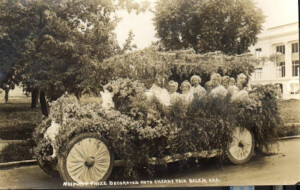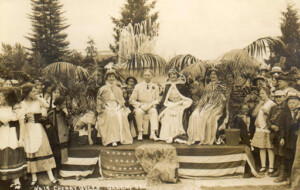Salem’s Cherry Festival
It was a gala occasion back in 1903 when the Salem Elks lodge sponsored a three-day celebration that was Salem’s first Cherry Fair. A festive air permeated the town as industrial displays and exhibits decked the sides of Court Street, games and contests were conducted at the State Fairgrounds, a floral parade unfolded, and boat races streaked the surface of the Willamette.

1912 c., Patton Brothers post card showing auto decorated for Salem’s Cherry Fair. Unfinished Supreme Courth Building in background., WHC Collections 0083.043.0001.103.18
Mrs. B.O. Schucking, then Agnes Gilbert, was the first queen who, with three princesses and two train bearers, completed the Royal Court. An automobile bedecked in cherry branches carried the royal party complete with parasols to Willson Park where the coronation took place. The late Henry W. Meyers placed the gold crown set in rubies and rhinestones on the head of the Queen and presented her with the key to the city.
In 1906, some of the first spirit of the affair was altered as the event became more of educational undertaking than a celebration. For, in that year, the Fair was timed in conjunction with the midsummer meeting of the Oregon Horticultural Society, which resulted in only a few exhibits and cup awards for premiums. Salem became known as the “Cherry City” as a result of the outstanding exhibits at the Cherry Fair held July, 1907.
Arranged by the Marion County Horticultural Society, this fair was held in connection with the fifth annual convention of the Pacific Coast Association of Nurserymen. It was these men who, after viewing the cherry exhibit, passed a resolution declaring it to be “the greatest and finest display of cherries known in history” and by unanimous vote christened Salem the Cherry City.
The Salem Board of Trade arranged the Cherry Fair held in 1908, having more of a festive spirit introduced than in the previous year with a street carnival held at the same time. The three-day events included baseball games (the Senators), floats, band concerts and singing on electric cars, fireworks, a military parade and competitive drill, a reception, a Grand Cherry Ball, and a fun Mardi Gras.
A baby parade was added to the agenda in 1911, and Marion Square became the pivot for all activity. The Salem Board of Trade presented its last festival in 1912. All of the previous fun-making was continued that year, with the addition of more night musical events.
After the Salem Cherrians were organized in 1913, they were appointed the task of producing the annual festival, which they did in the few years just preceding the First World War. Except for a smaller fair held in 1922 as a hospital fund benefit, the Cherry Festival disappeared from the calendar but not the memory of Salem citizenry.

1915 c., Titled “Cherry Queen of Salem, Oregon”. Three young women with tiaras, robes and long dresses seated on raised platform. Decorated with bunting. One older man seated with them. Crowd of on lookers, mainly children, on each side of the platform., WHC Collections 0082.024.0002.021
Then came the great rebirth of the custom which was once so closely associated with Salem. In 1947, the Salem Cherryland Festival Association was formed, and the wheel of local history rolled full circle. Salem’s summer season was complete again with a festive, colorful Cherryland Festival. Queen Martha DuRette of Gervais ruled that first event in the second series with a court of ten princesses. In 1948, the royal court was changed from eleven girls to nine and, in1949, the court was reduced to five.
As the blooms appear in the central Willamette Valley around Salem elating caravans of visitors come to enjoy the three-day festival. This is the time the Cherrians too, blossom out in uniforms to greet their guests. Everybody loves a parade and, in 1947, a Grand Parade was held at 10:00 a.m. sharp with floats and high school bands. The following day, a Children’s Parade took place with lots of prizes and free ice cream.
Included in the program for the three-day event was a Horse Show, Cherryland pageants, Air Show, and a Statewide Drill Team contest (drum and bugle corps). A magnificent trophy, donated personally by Governor Douglas McKay, was awarded to the best organization appearing in the annual statewide drill team contest, a feature of the Cherry-land festival.
After the 1950 festival, there is no record of when they ceased to exist, but those who participated or attended the festivities will have fond memories of them.
Compiled by Shirley Herrmann
Bibliography:
Statesman Journal newspaper, Life section – Sunday January 12, 1969
History of Salem Cherry Festivals, Magee, Margaret, brochure, Salem Public Library, 1950
This article originally appeared on the original Salem Online History site and has not been updated since 2006.







Leave A Comment